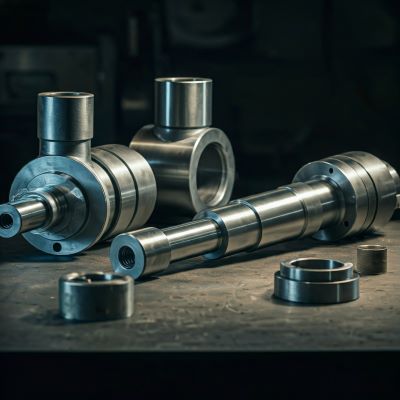Ever wondered about the powerful force behind heavy machinery and industrial automation? Hydraulic cylinders, with their seamless conversion of fluid power into linear motion, are at the heart of it all.
In this deep dive, we’ll explore the intricate components that make these machines so reliable and efficient. From the sturdy barrel to the precise seals, each part plays a crucial role in delivering peak performance.
How Do Hydraulic Cylinders Operate and What Is It?
A mechanical actuator that transforms fluid power into linear motion is called a hydraulic cylinder. It’s a fundamental component in countless industrial and mobile applications, from construction equipment to manufacturing machinery.
The Importance of Understanding Cylinder Components
To maximize the performance and longevity of a hydraulic cylinder, it’s essential to understand the role and function of its critical components. Each part, from the barrel to the seals, contributes to the overall efficiency and reliability of the system.
The Cylinder Barrel: Foundation of Hydraulic Strength
➡️ Function and Purpose: The cylinder barrel serves as the structural backbone of the cylinder, providing the necessary strength to withstand high pressures and heavy loads.
➡️ Materials Used: High-quality steel alloys, such as chrome-plated steel, are commonly used for their durability and resistance to corrosion and wear.
➡️ How Barrel Quality Affects Cylinder Efficiency: A well-manufactured barrel ensures precise alignment of internal components, minimizing friction and maximizing efficiency.
The Cylinder Rod: Precision and Power in Motion
➡️ Role in Hydraulic Systems: The cylinder rod transmits force from the piston to the load, enabling linear motion.
➡️ Key Considerations for Rod Materials and Coatings: Chrome-plated rods are popular due to their corrosion resistance and low-friction surface. Hard chrome plating can further enhance durability and extend the rod’s lifespan.
➡️ How Cylinder Rods Impact Performance and Reliability: A properly designed and manufactured rod ensures smooth, reliable operation and prevents premature failure.
Piston and Piston Seals: Creating Effective Pressure
➡️ How the Piston Converts Fluid Power into Motion: The piston is a critical component that divides the cylinder into two chambers. As hydraulic fluid is pressurized into one chamber, it forces the piston to move, generating linear force.
➡️ Different Types of Pistons for Specific Applications: Various piston designs, such as solid pistons, piston rings, and cup-type seals, are used to accommodate different pressure and speed requirements.
➡️ Importance of Piston Seals for Preventing Fluid Leaks: Piston seals are essential for maintaining hydraulic pressure and preventing fluid leakage, ensuring efficient operation.
End Caps and Head: Sealing the Cylinder Ends
➡️ Purpose of End Caps and Their Role in Pressure Retention: End caps seal the ends of the cylinder, preventing fluid leakage and providing structural support.
➡️ Choosing the Right Head Design for Strength and Accessibility: The head design should be selected based on the specific application and maintenance requirements. For example, a clevis-mount head offers flexibility in mounting options.
➡️ End Cap Maintenance Tips for Extended Cylinder Life: Regular inspection and lubrication of end caps can help prevent wear and ensure proper sealing.
Hydraulic Seals: Preventing Leaks and Contamination
➡️ Overview of Seal Types: Various seal types, including rod seals, piston seals, and wipers, are used to prevent fluid leakage and contamination.
➡️ Material Choices for Long-Lasting, Effective Sealing: High-quality elastomeric materials, such as polyurethane and nitrile rubber, are commonly used for their durability and resistance to wear and fluid degradation.
➡️ Common Seal Issues and How to Avoid Them: Proper installation, lubrication, and maintenance are crucial for preventing seal failure and ensuring optimal cylinder performance.
Ports and Fittings: Fluid Entry and Exit Points
➡️ Types of Ports and Fittings for Optimal Fluid Flow: Different types of ports, such as SAE and metric ports, are available to accommodate various hydraulic systems. Fittings, such as O-ring face seal fittings, ensure secure connections.
➡️ How Port Placement Affects Cylinder Performance: Proper port placement is essential for efficient fluid flow and optimal cylinder performance.
➡️ Choosing Fittings for Secure, Leak-Proof Connections: High-quality fittings with proper torque settings are crucial for preventing leaks and ensuring reliable operation.
Mounting Accessories: Stabilizing the Cylinder in Place
➡️ Types of Mounting Styles and Their Specific Uses: Various mounting styles, such as trunnion mounts, clevis mounts, and foot mounts, are available to suit different applications.
➡️ Choosing the Right Mounting Accessory for Stability: The appropriate mounting accessory should be selected based on the load, operating conditions, and space constraints.
➡️ Installation Tips for Secure, Reliable Mounting: Proper alignment, torqueing, and lubrication of mounting hardware are essential for secure and reliable mounting.
Maintenance and Troubleshooting Critical Components
➡️ Inspection Checklist for Hydraulic Cylinder Components: Regular inspection of the cylinder barrel, rod, piston, seals, and other components can help identify potential issues before they lead to failures.
➡️ Identifying Signs of Wear and When to Replace Parts: Signs of wear, such as scratches, pitting, or excessive clearance, indicate the need for replacement parts.
➡️ Troubleshooting Common Issues for Efficient Operation: Understanding common issues, such as fluid leaks, slow response times, and excessive noise, can help troubleshoot and resolve problems effectively.
Check out these other resources for your gain ⬇️⬇️⬇️
How Flat Face Hydraulic Fittings Enhance Performance
Why Socket Elbow Fittings Are Essential for Durable Systems
Conclusion: Why Quality Components Matter for Hydraulic Cylinders
By understanding the role and function of each critical component, you can select and maintain high-quality hydraulic cylinders that deliver optimal performance and reliability. Investing in quality components is essential for maximizing productivity and minimizing downtime.
Post time: Nov-05-2024


